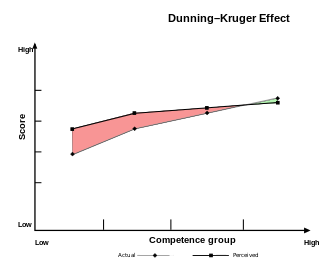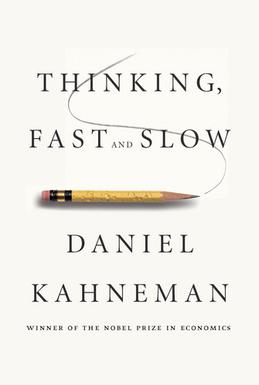
A cognitive bias is a systematic pattern of deviation from norm or rationality in judgment. Individuals create their own "subjective reality" from their perception of the input. An individual's construction of reality, not the objective input, may dictate their behavior in the world. Thus, cognitive biases may sometimes lead to perceptual distortion, inaccurate judgment, illogical interpretation, and irrationality.
In social psychology, fundamental attribution error, also known as correspondence bias or attribution effect, is a cognitive attribution bias where observers underemphasize situational and environmental factors for the behavior of an actor while overemphasizing dispositional or personality factors. In other words, observers tend to overattribute the behaviors of others to their personality and underattribute them to the situation or context. Although personality traits and predispositions are considered to be observable facts in psychology, the fundamental attribution error is an error because it misinterprets their effects.
Hindsight bias, also known as the knew-it-all-along phenomenon or creeping determinism, is the common tendency for people to perceive past events as having been more predictable than they were.
The representativeness heuristic is used when making judgments about the probability of an event being representional in character and essence of known prototypical event. It is one of a group of heuristics proposed by psychologists Amos Tversky and Daniel Kahneman in the early 1970s as "the degree to which [an event] (i) is similar in essential characteristics to its parent population, and (ii) reflects the salient features of the process by which it is generated". The representativeness heuristic works by comparing an event to a prototype or stereotype that we already have in mind. For example, if we see a person who is dressed in eccentric clothes and reading a poetry book, we might be more likely to think that they are a poet than an accountant. This is because the person's appearance and behavior are more representative of the stereotype of a poet than an accountant.
Trait ascription bias is the tendency for people to view themselves as relatively variable in terms of personality, behavior and mood while viewing others as much more predictable in their personal traits across different situations. More specifically, it is a tendency to describe one's own behaviour in terms of situational factors while preferring to describe another's behaviour by ascribing fixed dispositions to their personality. This may occur because peoples' own internal states are more readily observable and available to them than those of others.
The illusion of control is the tendency for people to overestimate their ability to control events. It was named by U.S. psychologist Ellen Langer and is thought to influence gambling behavior and belief in the paranormal. Along with illusory superiority and optimism bias, the illusion of control is one of the positive illusions.
The anchoring effect is a psychological phenomenon in which an individual's judgements or decisions are influenced by a reference point or "anchor" which can be completely irrelevant. Both numeric and non-numeric anchoring have been reported in research. In numeric anchoring, once the value of the anchor is set, subsequent arguments, estimates, etc. made by an individual may change from what they would have otherwise been without the anchor. For example, an individual may be more likely to purchase a car if it is placed alongside a more expensive model. Prices discussed in negotiations that are lower than the anchor may seem reasonable, perhaps even cheap to the buyer, even if said prices are still relatively higher than the actual market value of the car. Another example may be when estimating the orbit of Mars, one might start with the Earth's orbit and then adjust upward until they reach a value that seems reasonable.

Thomas Dashiff Gilovich an American psychologist who is the Irene Blecker Rosenfeld Professor of Psychology at Cornell University. He has conducted research in social psychology, decision making, behavioral economics, and has written popular books on these subjects. Gilovich has collaborated with Daniel Kahneman, Richard Nisbett, Lee Ross and Amos Tversky. His articles in peer-reviewed journals on subjects such as cognitive biases have been widely cited. In addition, Gilovich has been quoted in the media on subjects ranging from the effect of purchases on happiness to perception of judgment in social situations. Gilovich is a fellow of the Committee for Skeptical Inquiry.
In the psychology of affective forecasting, the impact bias, a form of which is the durability bias, is the tendency for people to overestimate the length or the intensity of future emotional states.
Depressive realism is the hypothesis developed by Lauren Alloy and Lyn Yvonne Abramson that depressed individuals make more realistic inferences than non-depressed individuals. Although depressed individuals are thought to have a negative cognitive bias that results in recurrent, negative automatic thoughts, maladaptive behaviors, and dysfunctional world beliefs, depressive realism argues not only that this negativity may reflect a more accurate appraisal of the world but also that non-depressed individuals' appraisals are positively biased.

The Dunning–Kruger effect is a cognitive bias in which people with limited competence in a particular domain overestimate their abilities. Some researchers also include the opposite effect for high performers: their tendency to underestimate their skills. In popular culture, the Dunning–Kruger effect is often misunderstood as a claim about general overconfidence of people with low intelligence instead of specific overconfidence of people unskilled at a particular task.
Positive illusions are unrealistically favorable attitudes that people have towards themselves or to people that are close to them. Positive illusions are a form of self-deception or self-enhancement that feel good; maintain self-esteem; or avoid discomfort, at least in the short term. There are three general forms: inflated assessment of one's own abilities, unrealistic optimism about the future, and an illusion of control. The term "positive illusions" originates in a 1988 paper by Taylor and Brown. "Taylor and Brown's (1988) model of mental health maintains that certain positive illusions are highly prevalent in normal thought and predictive of criteria traditionally associated with mental health."
Self-enhancement is a type of motivation that works to make people feel good about themselves and to maintain self-esteem. This motive becomes especially prominent in situations of threat, failure or blows to one's self-esteem. Self-enhancement involves a preference for positive over negative self-views. It is one of the three self-evaluation motives along with self-assessment and self-verification . Self-evaluation motives drive the process of self-regulation, that is, how people control and direct their own actions.
In social psychology, illusory superiority is a cognitive bias wherein a person overestimates their own qualities and abilities compared to other people. Illusory superiority is one of many positive illusions, relating to the self, that are evident in the study of intelligence, the effective performance of tasks and tests, and the possession of desirable personal characteristics and personality traits. Overestimation of abilities compared to an objective measure is known as the overconfidence effect.
The spotlight effect is the psychological phenomenon by which people tend to believe they are being noticed more than they really are. Being that one is constantly in the center of one's own world, an accurate evaluation of how much one is noticed by others is uncommon. The reason for the spotlight effect is the innate tendency to forget that although one is the center of one's own world, one is not the center of everyone else's. This tendency is especially prominent when one does something atypical.
Heuristics is the process by which humans use mental shortcuts to arrive at decisions. Heuristics are simple strategies that humans, animals, organizations, and even machines use to quickly form judgments, make decisions, and find solutions to complex problems. Often this involves focusing on the most relevant aspects of a problem or situation to formulate a solution. While heuristic processes are used to find the answers and solutions that are most likely to work or be correct, they are not always right or the most accurate. Judgments and decisions based on heuristics are simply good enough to satisfy a pressing need in situations of uncertainty, where information is incomplete. In that sense they can differ from answers given by logic and probability.

Thinking, Fast and Slow is a 2011 popular science book by psychologist Daniel Kahneman. The book's main thesis is a differentiation between two modes of thought: "System 1" is fast, instinctive and emotional; "System 2" is slower, more deliberative, and more logical.
Illusion of validity is a cognitive bias in which a person overestimates their ability to interpret and predict accurately the outcome when analyzing a set of data, in particular when the data analyzed show a very consistent pattern—that is, when the data "tell" a coherent story.
Debiasing is the reduction of bias, particularly with respect to judgment and decision making. Biased judgment and decision making is that which systematically deviates from the prescriptions of objective standards such as facts, logic, and rational behavior or prescriptive norms. Biased judgment and decision making exists in consequential domains such as medicine, law, policy, and business, as well as in everyday life. Investors, for example, tend to hold onto falling stocks too long and sell rising stocks too quickly. Employers exhibit considerable discrimination in hiring and employment practices, and some parents continue to believe that vaccinations cause autism despite knowing that this link is based on falsified evidence. At an individual level, people who exhibit less decision bias have more intact social environments, reduced risk of alcohol and drug use, lower childhood delinquency rates, and superior planning and problem solving abilities.



